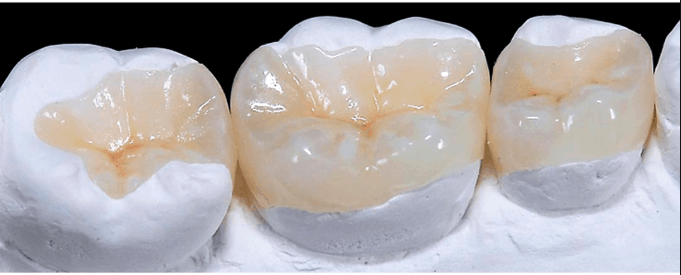TOOTH FILLING LIVERPOOL
Restore your smile in one visit with discreet, durable white fillings from Smileworks Liverpool.
Sometimes our teeth crack or get damaged. This can happen for many reasons, but some of the most common are tooth decay, grinding, or trauma. On the back teeth, fractures can happen from simply biting and chewing food. It’s an incredibly common dental problem, and the best way to fix it is with a tooth filling.
With over 1.5k reviews, Smileworks is Liverpool’s top choice for tooth fillings. Our expert dentists use only the best dental materials and techniques to fill in the cracks or holes in your teeth. Our white tooth fillings blend in seamlessly with your natural tooth and are a great option for those with tooth damage or those looking to replace their old silver (amalgam) fillings.
⭑⭑⭑⭑⭑
Fantastic service and such lovely staff! Emma & Andreea worked on removing an old silver filling and replaced it with a new white one. I was nervous at first but they did such a fantastic job at making me comfortable. I was so impressed, I don't think I will ever be scared to go to the dentist again. Very, very pleased thank you so much!
Lilly B. | 2024
what is a tooth filling?
A tooth filling is a very common dental procedure performed to remove and then fill in any surface areas of the tooth where decay or damage is present. These can be tooth cracks or even holes, usually occurring in your back teeth.
It’s important to address this tooth damage as soon as possible, especially if it’s due to tooth decay. If decay is left untreated, the bacteria creates acids and harmful by-products that can eat away at the inner part of your tooth, where nerves and blood vessels live. When this happens, the hole or fissure grows bigger and serious cavities can form.
To prevent any further damage or decay, a dentist or dental therapist will fill in your tooth with a special dental material. In the past, fillings were nearly always silver, made from a mixture of different metals. The issue with these fillings is that they can be seen when you laugh, smile, or eat. While they are functional, they are not ideal aesthetically.
How Do I Know If I Need One?
Pain is usually the first indication that you might need a tooth filling. If you experience any sort of tooth pain, you should book an appointment with us straight away. If you put off getting it checked out, the tooth could worsen, and you might need more expensive treatments like a dental crown, root canal, or porcelain veneers.
The best way to know if you need a tooth filling is to come in for a consultation. One of our skilled dentists or dental therapists will take a look at your tooth and find out the best course of treatment We want to get you a result that makes you feel great.
If you have a silver/amalgam filling that you want to replace with a white tooth filling, we can do this as well. You don’t have to wait for your old filling to start showing damage. Just book an appointment today, and we’ll get you sorted with a new white filling.
tooth filling benefits

NATURAL APPEARANCE
White fillings are tooth-coloured and can be precisely matched to your natural tooth shade, making them virtually invisible.

Keeps Tooth Healthy
Tooth fillings bond directly to the tooth, helping to seal and protect it from further decay and damage in the long-term.

Strong And Durable
When properly placed, white tooth fillings are strong and wear-resistent, especially for small to medium-sized restorations.

Free From Mercury
Unlike silver amalgam fillings, white fillings are mercury-free and considered both safer and more aesthetically pleasing.
silver vs white tooth fillings
Here at Smileworks, the vast majority of our tooth filling procedures are done using white composite resin. You may already be aware of composite resin because of its use in popular cosmetic treatments like composite veneers or composite bonding.
Composite resin is made of plastic and glass. This combination creates a hard material that is very similar to your natural tooth enamel. It is then sculpted into your cavity and finished to produce an extremely life-like and translucent look. Just like your natural tooth.
Silver or amalgam fillings, on the other hand, are slowly being phased out in the dental industry. Most people prefer the discreet look of white tooth fillings, and in 2025, the extra five years of lifespan offered by amalgam (20 years vs 15 for composite) simply isn’t worth it.
To create the silver colour, amalgam fillings are made from a mixture of metals including silver, tin, copper, and mercury. There is some debate in dentistry whether the small amount of mercury in amalgam comes with added health risks. We want to keep our patients as safe as possible, so we only perform silver/amalgam fillings if you explicitly ask for them.
what about dental onlays?
For those with more extensive damage to your tooth, an onlay might be necessary over a traditional filling. An onlay is very similar to a filling, but it’s instead made in a dental lab and then applied to your teeth here at Smileworks. Imagine an onlay like a mini-crown. It covers the cusps of the tooth.
If you’re deemed suitable for an onlay, an impression is taken of your teeth by your dentist and sent off to a dental lab. There, a master ceramist will create your onlay, making sure it blends seamlessly with your natural tooth. The onlay is then sent back to us, and we’ll apply it to your tooth with composite resin.
You’ll typically only need an onlay if the area that needs filling is too large to survive in the tooth or if it covers too many tooth surface areas. We’ll explain all of this in more detail at your appointment, but you can also always send us an email or give us a call if you have any additional questions.

the tooth filling process
At Smilworks Liverpool, we make restoring and keeping your teeth healthy simple, efficient, and pain-free. Here’s what you can expect from the tooth filling process:
1. Initial Assessment & Preparation
First, your dentist or dental therapist will assess the tooth and surrounding area, identifying any decay or damage. If you’re replacing an old filling, this is where we’ll remove it, along with any decay, tartar, or bacteria present. The goal is to create a clean, healthy foundation for your new filling.
2. Thorough Cleaning
We’ll meticulously clean the tooth to make sure any harmful bacteria is removed. This step is essential for ensuring your filling bonds properly and your tooth stays protected long term.
3. Layered Composite Application
Next, we apply a tooth-coloured composite resin in carefully placed layers. Each layer is shaped to follow your natural tooth contours and mimic the light-reflecting properties of real tooth enamel, giving your filling a seamless, lifelike appearance.
4. Bonding & Sculpting
To ensure your filling stays strong and secure, we use a special bonding agent that helps the composite adhere firmly to your tooth. Your dentist or dental hygienist will then sculpt the composite material with precision, matching the natural anatomy of your old tooth.
5. Hardening & Polishing
Once sculpted, the filling is hardened using a high-intensity curing light. We then refine and polish the surface so it blends perfectly with your other teeth, not just in colour, but also in texture and shine.
6. Enjoy A Durable, Long-Lasting Result
Your new filling is now ready to handle everything from chewing to smiling. With good oral hygiene and regular check-ups, white fillings can last well over a decade and help prevent any future decay or damage.

why choose smileworks?
At Smileworks, we’re not just about keeping your teeth healthy. We’re about delivering an exceptional first-class experience. Your happiness and confidence is our utmost priority, and you’ll see this throughout every step of your journey with us.

Liverpool's Most Trusted Dentist
With over 1.5k reviews and thousands of happy patients, Smileworks is the highest-rated dental practice in Liverpool.

Custom-designed Treatment Plans
Dentistry is not a one-size-fits-all industry. That’s why we tailor every treatment to your unique smile goals.

State-of-the-Art Technology
We use only the most advanced composite resin to produce more lifelike and better results for our patients.
tooth filling price uk
The cost of your filling depends on how many of the tooth’s surfaces are damaged or decayed. By tooth surfaces, we don’t mean number of teeth. Each tooth has a number of individual surfaces, and your price will be based on how much work it takes to restore the tooth. Anything more than four tooth surfaces may need other types of treatments, like dental crowns or porcelain veneers.
One Tooth Surface Filling | £185
2+ Surface Filling | From £205
Re-cement Crown or Veneer | £150
Tooth Extraction | £200 - £495
Emergency Assessment | £110
Removal of Nerve | £150
Temporary Dressing | £150
Fissure Sealant | £32.50 per tooth
We understand some dental work can get expensive. That's why we offer 0% APR patient finance options through Medenta Finance (subject to age and status, minimum spend applies). For more information on financing, give our friendly front of house team a call at 0151 236 5166. They’re here to help!
your tooth filling dentists & therapists
FAQ
What is in a tooth filling?
This depends on the materials used in the tooth filling. White tooth fillings are made from composite resin, a strong tooh-coloured material that bonds to your natural tooth. It contains a mix of plastic and fine glass particles, designed to restore strength and match the look and colour of your natural teeth.
Traditional silver fillings (also called amalgam fillings) are made from a mixture of metals including mercury, silver, tin, and copper. While slightly more durable than white tooth fillings, they’re more visible in the mouth and don’t bond to the tooth the same way.
What kind of fillings are available?
At Smileworks, we offer a range of materials. For most patients, we opt for white composite fillings due to their strength and natural appearance. We’ve never had a patient who doesn’t love their white tooth filling. However, if you prefer an amalgam filling, we can do this as well. In some cases with more extensive tooth decay, we may also recommend inlays, onlays, or crowns.
Are white fillings worth it?
Yes. If you want your tooth to look natural and not be noticeable when you smile, eat or laugh then composite fillings are the best option and are certainly worth it. The filling material is more compatible with your natural tooth and can be shaped better to look natural, lifelike, and beautiful.
Why should I consider white fillings?
White tooth fillings are natural-looking, mercury-free, and bond directly to the tooth. This makes them a safer, more aesthetic option compared to traditional silver (amalgam) fillings. They’re ideal for treating tooth decay and replacing old metal fillings.
How long do tooth fillings last?
Like any dental restoration, a filling will last longer if you look after it. Brushing, flossing, and going to the dentist regularly and flossing can extend its life. If you eat lots of sugar, don’t brush, and avoid the dentist it will fail more quickly. That said, no white tooth filling will last forever. We find they usually last up to 15 years.
How long can I eat after a tooth filling?
If you’ve had a white tooth filling, you can usually eat as soon as the numbness wears off. This will typically be within a couple hours. However, it’s best to avoid hard, sticky, or very hot foods for the rest of the day to allow the filling to settle. Your dentist or dental therapist will always give you more detailed instructions at the end of your appointments. Never be afraid to ask if you’re unsure!
How much is a tooth filling?
At Smileworks, our tooth fillings start from £185. The exact cost depends on the size and the location of the filling. We aim to be 100% transparent with our prices, so we’ll always provide a clear treatment plan before we go ahead.
Does the treatment hurt?
No, not at all. Getting a tooth filling is a quick, comfortable, and pain-free experience. We use local anaesthetic to numb the area to make sure you feel no pain during the procedure. Your dentist or dental therapist will check in with you throughout the course of the procedure to make sure you are completely relaxed and comfortable.
How to relieve tooth pain after filling?
Mild sensitivity or discomfort is common for a few days after your procedure. We recommend avoiding very hot, cold, or sweet foods. Take over-the-counter pain relief like paracetamol or ibuprofen if needed. If the pain persists beyond a week or gets worse, get in touch right away so we can check everything is healing as expected. We have a limited number of emergency appointments available each day for circumstances like this.
Why does my tooth filling hurt after months?
Experiencing some mild pain after a tooth filling is normal. This usually presents as cold sensitivity, but pain with hot drinks/foods or when you bite needs to be investigated. This could mean that a nerve of the tooth is compromised. This is a sign that the tooth is dying off and might need an extraction or root canal treatment. If your filling hurts after months, this is definitely not normal, and you should get in touch with your dentist as soon as possible.
How do I book?
At Smileworks, we make booking easy! Use our online booking system to quickly schedule your consultation. If you prefer to book over the phone, you can give us a call at 0151 236 5166.
Any other questions?
No problem! Get in touch, and our friendly team will be happy to help. You can reach us with any additional questions at 0151 236 5166 or through email at tco@sexydentistry.com.

To find us, click on the map above or Google 'tooth filling near me'.





